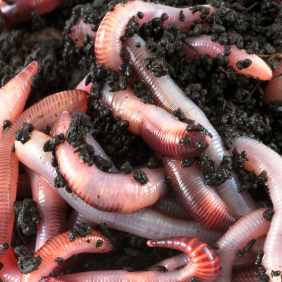Making Use Of Red Wigglers for Efficient Organic Waste Disposal
These worms not only enhance waste decomposition but additionally produce useful worm spreadings, which can substantially enhance soil wellness. Recognizing the subtleties of setting up a successful worm container and keeping an ideal habitat is crucial for optimizing their advantages.
Benefits of Making Use Of Red Wigglers
Among the most engaging benefits of using red wigglers for natural waste disposal is their amazing efficiency in composting. These worms, medically called Eisenia fetida, are specifically adjusted for breaking down natural materials, allowing them to process waste approximately twice their body weight each day. This quick decay not just speeds up the composting process however also generates nutrient-rich worm castings that dramatically improve soil high quality.
Additionally, red wigglers add to a reduction in land fill waste. By diverting natural materials from garbage dumps, they help lessen methane emissions-- a powerful greenhouse gas. This ecological benefit is crucial in the battle versus climate adjustment.
Furthermore, red wigglers are low-maintenance and can grow in different settings, making them easily accessible for both novice and seasoned composters. Their ability to reproduce swiftly ensures a consistent population, assisting in recurring waste processing.
Establishing Your Worm Container
Creating a reliable worm bin is crucial for making best use of the benefits of composting with red wigglers. The primary step is selecting a proper container. A container made from plastic or timber, with an ability of 10 to 20 gallons, is ideal. Guarantee the bin has ample drain openings to stop excess dampness, as red wigglers grow in a wet yet not soggy environment.
Once the bin is established, present the red wigglers, permitting them to acclimate to their new environment. It's essential to keep an eye on dampness degrees and temperature level frequently. A properly maintained container will certainly not just sustain the wellness of the worms yet additionally promote reliable disintegration of natural waste. By adhering to these standards, you can develop a thriving ecosystem that adds to lasting waste monitoring.
What to Feed Red Wigglers
An understanding of the ideal diet plan for red wigglers is essential for keeping a healthy and balanced worm population and enhancing composting performance. Red wigglers flourish on a diverse diet plan that largely consists of organic materials. Suitable food resources have a peek here consist of veggie scraps, fruit peels, coffee premises, eggshells, and shredded paper. These items not only supply crucial nutrients but also contribute to the wetness balance within the worm bin.
It is crucial to avoid certain foods that can harm the worm population. Red wigglers must not be fed meat, dairy products, oily foods, or processed things, as these can bring in parasites and develop undesirable odors. red wigglers. Additionally, citrus fruits and spicy foods need to be decreased, as their level of acidity can be destructive to worms
Keeping an eye on the worm bin for food intake rates will certainly assist guarantee that red wigglers are receiving an adequate diet while maintaining a reliable composting atmosphere. Proper feeding techniques are crucial for promoting a thriving environment within the worm bin.
Keeping Your Worm Habitat
A well-maintained worm habitat is necessary for the health and efficiency of red wigglers. To make certain optimal conditions, it is vital to monitor temperature, wetness, and oygenation within the worm container. Red wigglers grow in a temperature variety of 55 to 77 levels Fahrenheit. Surpassing this array can stress the worms, so it is very important to put the bin in an appropriate area far from straight sunshine and severe temperatures.
An excellent policy of thumb is to preserve wetness at roughly 70% to 80%. If the bedding becomes also damp, it can lead to anaerobic conditions that are damaging to the worms.

Utilizing Worm Castings in Gardening
Rich in nutrients and useful bacteria, worm castings work as an extraordinary natural fertilizer for gardening. Produced via the digestive system procedures of red wigglers, these castings contain an array of important nutrients, including nitrogen, phosphorus, and potassium, which promote durable plant development. Unlike synthetic fertilizers, worm spreadings provide a slow-release mechanism, ensuring that nutrients are readily available to plants over a prolonged period, therefore lowering the danger of nutrient leaching and soil deficiency.
In enhancement to nutrition web content, worm castings improve dirt structure and aeration, boosting moisture retention and drain. The microbial life existing in worm castings assists to subdue virus and promotes a healthy dirt ecosystem, further profiting plant wellness. When incorporated into the soil or made use of as a leading dressing, worm castings can considerably enhance seed germination rates, root development, and general plant vitality.
For optimum outcomes, garden enthusiasts should apply worm castings at a rate of 1-2 inches per square foot, mixing them right into the dirt or including them right into potting blends. Overall, using worm castings is an environment-friendly strategy to enriching soil fertility and guaranteeing prospering yard settings.
Conclusion

Comments on “Red worms: How to raise a worm bin”